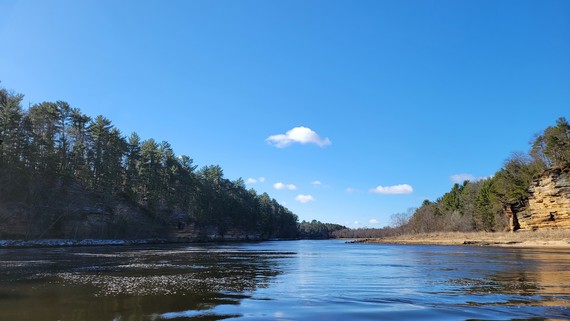|
May 2, 2022

DNR Celebrates Air Quality Improvements, Accomplishments And Public Outreach
May is Clean Air Month, and the Wisconsin Department of Natural Resources (DNR) celebrates the accomplishments of the last year, including the improvement in overall air quality in Wisconsin.
The DNR’s 2021 Wisconsin Air Quality Trends Report shows that air quality in Wisconsin continues to improve, including a 35% drop in fine particle concentrations, a dramatic reduction in emissions from industrial sources and motor vehicles and a 39% drop in industrial source emissions of volatile organic compounds (VOCs).
These improvements are due in part to implementing a variety of federal and state pollution control programs, and cleaner burning and more efficient fuel combustion from both highway vehicles and electric utilities.
Because of these programs, the entire state is meeting federal air standards for pollutants including particulate matter, nitrogen dioxide, sulfur dioxide, carbon monoxide and lead.
“The DNR works closely with entities such as the Environmental Protection Agency, research and scientific organizations, businesses and non-profits to reduce air emissions and improve air quality across the state,” said Gail Good, DNR Acting Environmental Management Division Administrator. “The Air Management Program is continually focused on finding innovative and ground breaking tools and resources to monitor air quality and relay air quality information to the public.”
Earlier this year, the DNR debuted a new air quality display at the Sanderling Nature Center in Kohler-Andrae State Park. The display showcases air quality data gathered from the state-of-the-art equipment onsite at the nature center, and is visible from the center or the beach.
“Kohler-Andrae State Park is a great summer destination and is open for all,” said Kristin Hart, DNR Acting Air Management Program Director. “If you are heading to the park, be sure to visit the new display to learn about DNR’s air quality monitoring tools and resources.”
Other ongoing efforts to enhance customer service and provide environmental protection across Wisconsin include:
-
Increase Public Involvement – The Air Management Program’s Public Notice webpage has new resources to improve public access to DNR permit actions and increase awareness of public participation opportunities during the permitting process. Additional information is available on the following DNR webpages: Air Permit Applications Received, Air Public Notices and Air Permit Final Decisions.
-
Promote Emissions Reduction Credits – The DNR recently launched the Emissions Reduction Credit webpage to promote economic growth and development in nonattainment areas, which have more restrictive permitting requirements and may be subject to more stringent regulations while ensuring continued improvement in air quality for Wisconsin residents. Currently, the Emissions Reduction Credit registry can be used in ozone nonattainment areas and connects entities interested in buying, selling or generating Emissions Reduction Credits to meet Nonattainment New Source Review permitting requirements.
-
Meet Federal Sulfur Dioxide (SO2) Standards – On Jan. 12, 2022, the U.S. Environmental Protection Agency (EPA) approved a request by the DNR to redesignate the area around Rhinelander as attainment for the 2010 1-hour sulfur dioxide (SO2) National Ambient Air Quality Standard (NAAQS). This designation officially recognized that the air quality in the Rhinelander area is meeting this health-based air quality standard. The EPA’s announcement also means that all of Wisconsin is now meeting the 2010 SO2 Statewide, emissions of SO2 from sources are about 90% lower than 2002 levels, with most of this decline attributable to the use of cleaner-burning fuels at power plants and industrial facilities, along with the introduction of low-sulfur diesel fuels.
-
Conduct Enhanced Ozone Monitoring (EOM) – This past fall, the DNR shared the enhanced ozone monitoring program with members of the Environmental Council of the States (ECOS) with a video capturing the work being done. In addition to the DNR’s 30 stationary air quality monitors across the state, the Air Management Program continues to use several other cutting-edge techniques to tackle the long-standing ground-level ozone challenges impacting areas along Wisconsin’s Lake Michigan shoreline. Using Raspberry Pi micro-computers, a mobile air monitoring lab and vertical air column monitoring techniques, the DNR’s Air Management Program is paving the way nationally for new ozone monitoring techniques and tools. The program also partners with the University of Wisconsin-Madison, NASA, EPA and the Lake Michigan Air Directors Consortium (LADCO), a collaborative of Great Lakes states, to further expand the ozone research effort.
To get kids involved in the air quality celebration, the DNR’s 11th annual Air, Air Everywhere poetry contest is underway. The department is accepting entries from Wisconsin’s third, fourth and fifth grade students through May 6. Winners will be announced at the end of the month, and the three winning poems will be posted to the program’s Air, Air Everywhere poetry contest webpage.
The DNR offers a variety of ways to stay up to date on the current air quality. Download the free WisconsinAQM mobile app to receive air quality updates from anywhere using their mobile device. The app includes an interactive map of near real-time data from the state’s air monitoring network, individual monitoring station reports, weather information and more. Download from the Apple App Store or Google Play Store.
Stay up-to-date by subscribing to the DNR's air quality news and notices newsletter and visit the DNR’s Clean Air Month webpage for links to resources and more information.
|